Derivatives of Exponential Functions: Video Lesson
How to Differentiate ex
The derivative of ex is ex. Therefore e to the power of x remains unchanged when it is differentiated. This is the only function to have this property. The derivative of ekx is kekx. For ex, k=1 and so, the derivative of ex is ex.

Since the derivative of ex is just ex, the graph of the derivative of ex looks identical to ex.
| Exponential Function | Derivative |
| y=ex | y’=ex |
| y=ekx | y’=k.ekx |
| y=ef(x) | y’=f'(x).ef(x) |
| y=ax | y’=ln(a).ax |
How to Differentiate an Exponential Function
To differentiate an exponential function, copy the exponential function and multiply it by the derivative of the power. For example, to differentiate f(x)=e2x, take the function of e2x and multiply it by the derivative of the power, 2x. The derivative of 2x is 2. Therefore the derivative of f(x)=e2x is f'(x)=2e2x .
The derivative of e2x is 2e2x.

The rule for differentiating an exponential function is that for f(x)=eu, the derivative is f'(x)=u’.eu.
u is the function found in the power of the exponential and u’ is the derivative of this function.
In words, the rule for differentiating an exponential is to multiply the original exponential function by the derivative of its power.


The rule for differentiating exponential functions is that for f(x)=eu then f'(x)=u’.eu, where u is the function in the power of the exponential and u’ is the derivative of this function. For f(x)=e2x, u = 2x and u’ = 2. Therefore f'(x)=2e2x.
Examples of Differentiating Exponential Functions
To differentiate any exponential function, differentiate the power and multiply this by the original function.
This can be written mathematically as when ,
.
Alternatively, this can be written as when ,
.


For example, differentiate f(x) = e3x.
u is the power of the exponential, which is 3x.
u’ is the derivative of u. Differentiating 3x, we get u’ = 3.
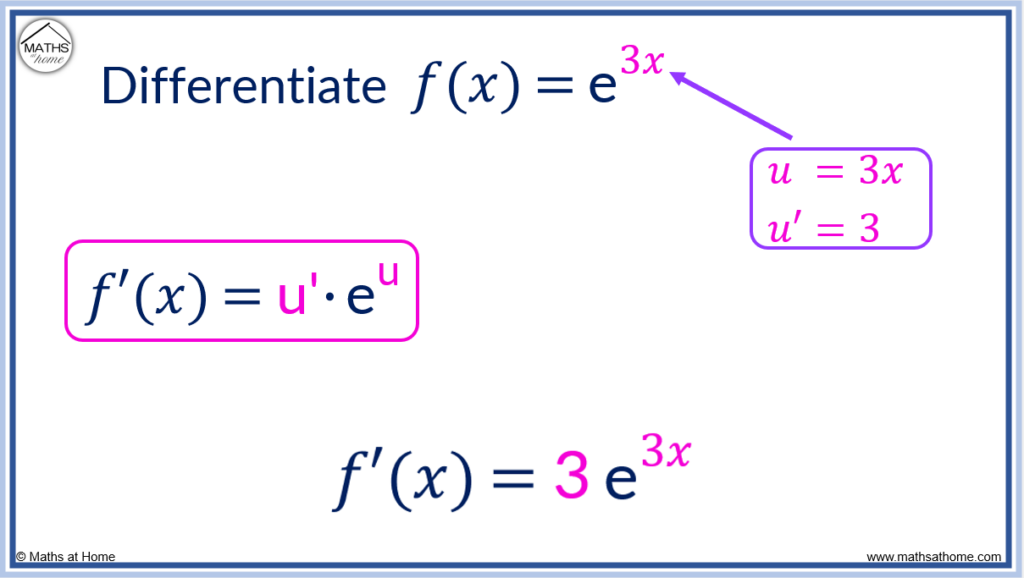
Substituting u = 3x and u’ = 3 into f'(x) = u’.eu, we get f'(x) = 3e3x.
For example, differentiate f(x)=ex2.
u = x2 and so, u’ = 2x.
Therefore f'(x) = u’ . eu becomes f'(x) = (2x).ex2.
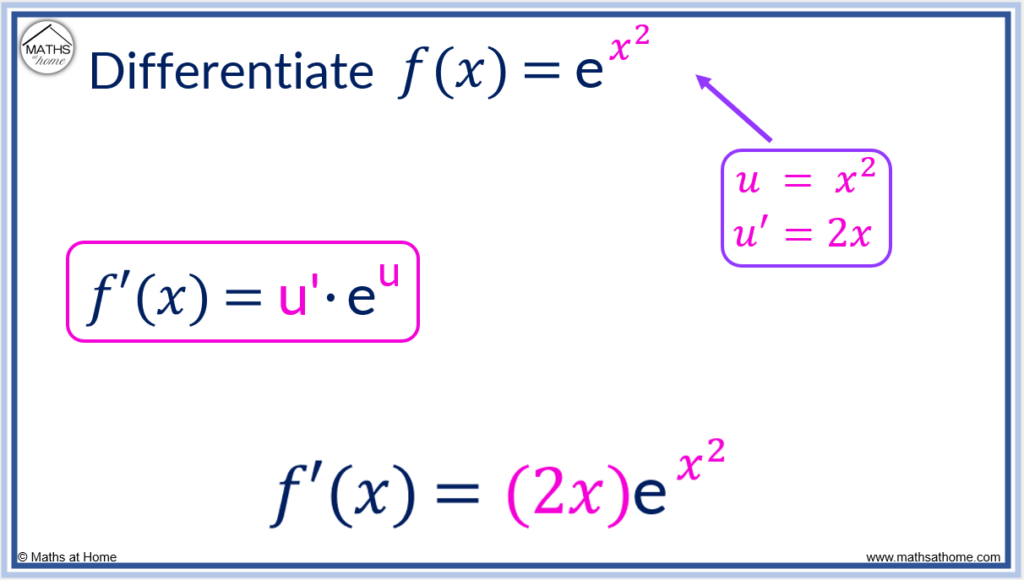
For example, differentiate f(x)=ex2+3x .
u = x2+3x and so, u’ = 2x+3.
Therefore f'(x) = (2x+3).ex2+3x.
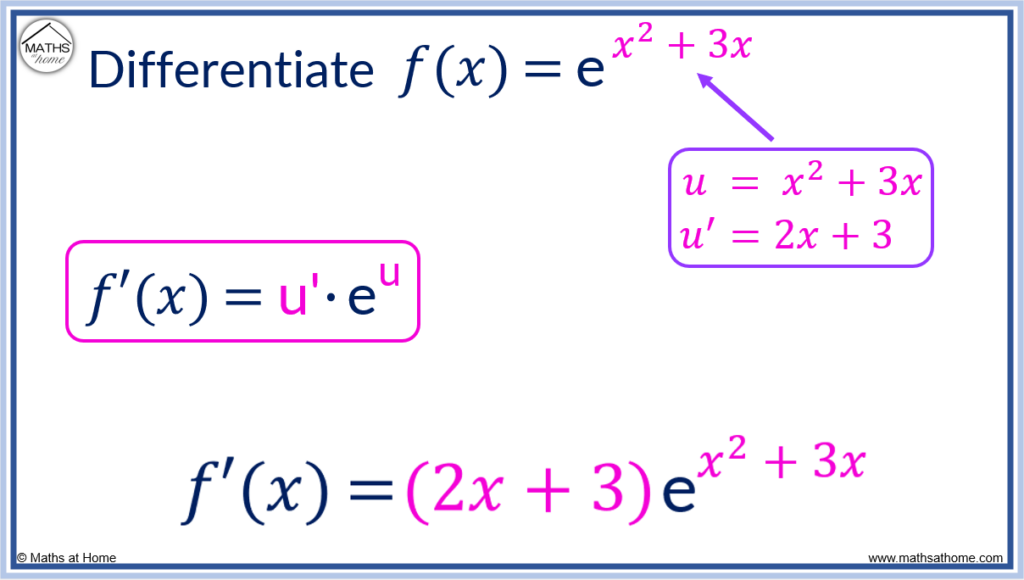
For example, differentiate f(x) = e1/x.
If the power of the exponential function is a fraction, rewrite it as an indice.
1/x can be rewritten as x-1. Writing this fraction as an index allows us to differentiate it.
u = x-1 and so, u’ = -x-2.
Therefore f'(x) = (-x-2)ex-1.
This can also be written as or
.

For example, differentiate esin(x).
u = sin(x) and so, u’ = cos(x).
Therefore f'(x) = cos(x).esin(x).
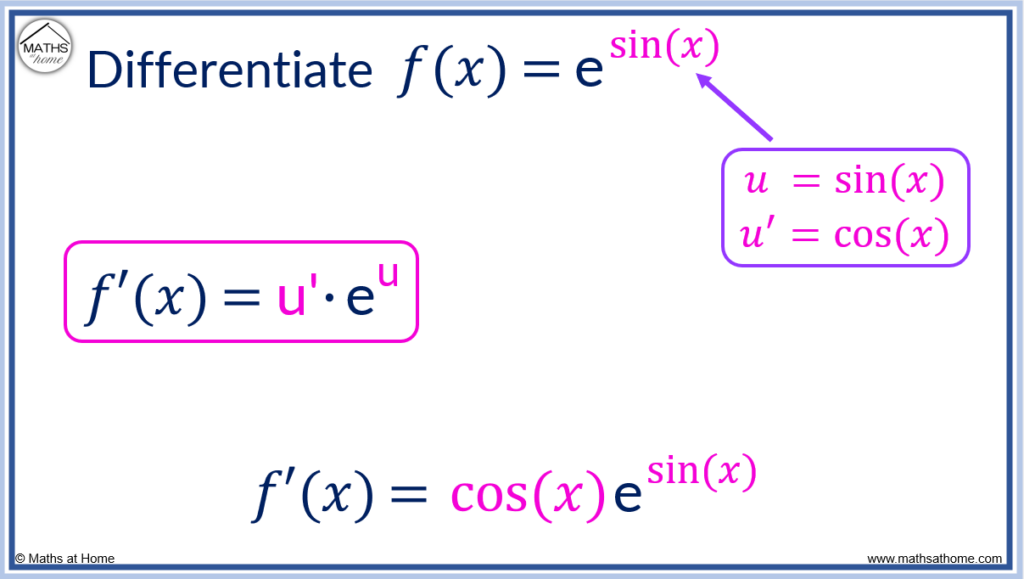
Here are some examples of differentiating exponential functions with solutions.
| Exponential Function | Derivative |
| ex | ex |
| ekx | kekx |
| e3x | 3e3x |
| 5e2x | 10e2x |
| ex2 | (2x).ex2 |
| e(2x3-x2) | (6x2-2x).e(2x3-x2) |
| e-x | -e-x |
| esin(x) | cos(x).esin(x) |
Chain Rule with Exponential Functions
The chain rule is used to differentiate a function of a function. The chain rule states that .
The rule for differentiating exponential functions can be used in conjunction with the chain rule.
For example, differentiate y = sin(ex).
We can write this as y = sin(u), where u = ex.
Therefore, and
.
Using the chain rule, and so,
.
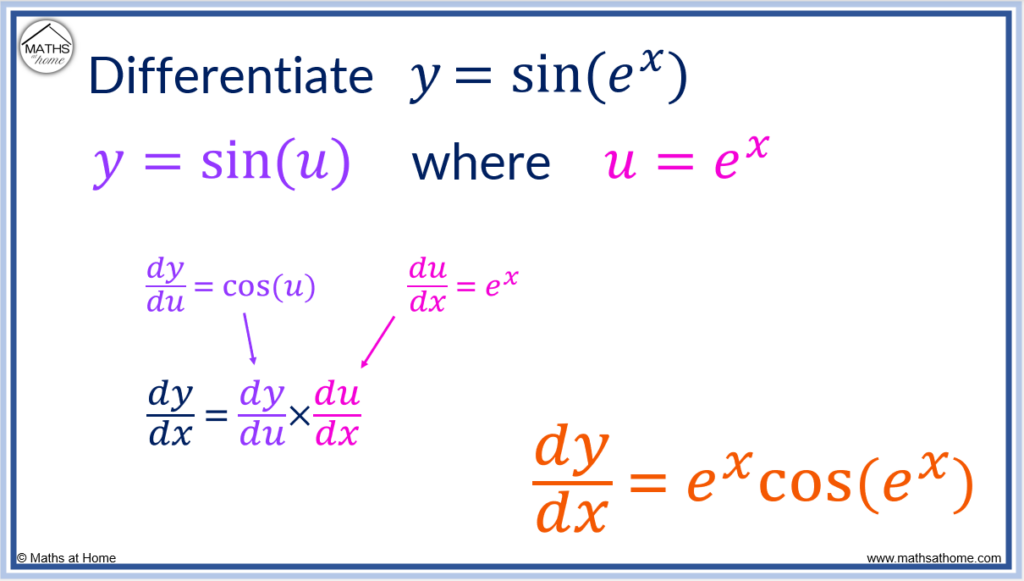
Product Rule with Exponential Functions
The produce rule states that for a function , the derivative is
.
Our rule for differentiating exponentials can be used alongside the product rule.
For example, differentiate y=xex.
Here u = x and v = ex.
Therefore and
.
Using the product rule, , the derivative is
.
We can factorise out the ex term so that .

Quotient Rule with Exponential Functions
The quotient rule is .
Here is an example of using the quotient rule to differentiate exponential functions.
Differentiate .
With the quotient rule, u is the function on the numerator and v is the function on the denominator.
u = ex and so .
v = x and so, .
Substituting these values into the quotient rule, .
This can be simplified by factorising out the ex term.
.
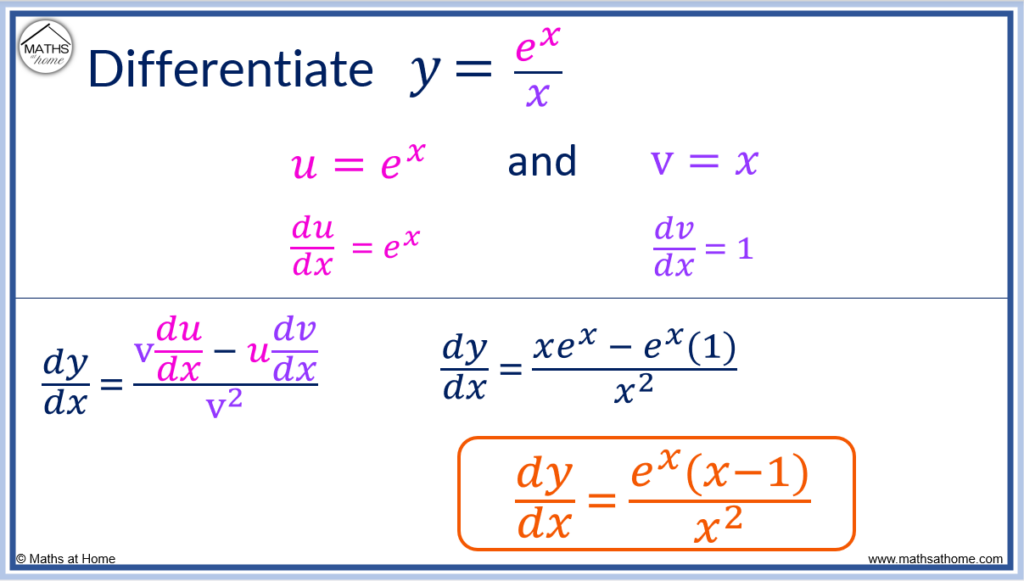
Implicit Differentiation of exy
To differentiate exy, use f'(x)=u’.eu where u = xy.
Use the product rule to differentiate the power of ‘xy’ implicitly.
Implicit differentiation tells us that the derivative of y is y’.
If u = xy, the product rule gives us u’ = (1)(y)+(x)(y’) which simplifies to u’ = y + xy’.
Therefore the derivative of exy is (y+xy’)exy.

If , then
.
- Use implicit differentiation to differentiate xy to get y + xy’.
- Collect y’ terms together
- Factorise the y’ terms
- Solve the equation for y’

Proof of the Derivative of e𝑥
Here is an algebraic proof of why the derivative of ex is itself.
- Suppose y = ex
- Take the natural logarithm of both sides so that ln|y|=x
- Differentiating both with respect to x, the result is (1/y)(dy/dx) = 1
- Multiplying both sides by y, the result is dy/dx = y
- Substituting y = ex, the result is dy/dx = ex
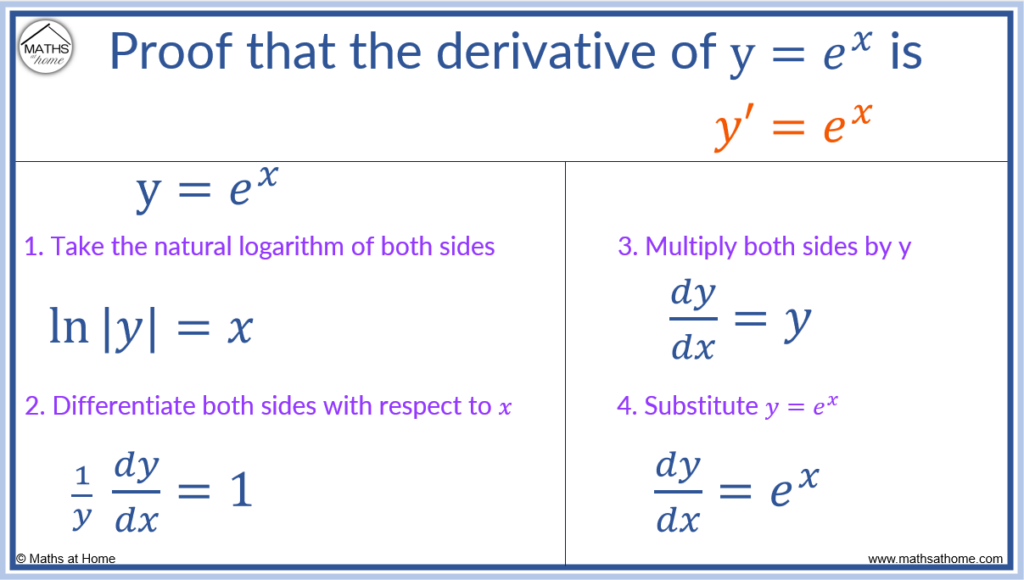
Derivative of e𝑥 using first principles
The derivative of ex can be found using differentiation by first principles.
The first principles formula states that the gradient function can be found using .
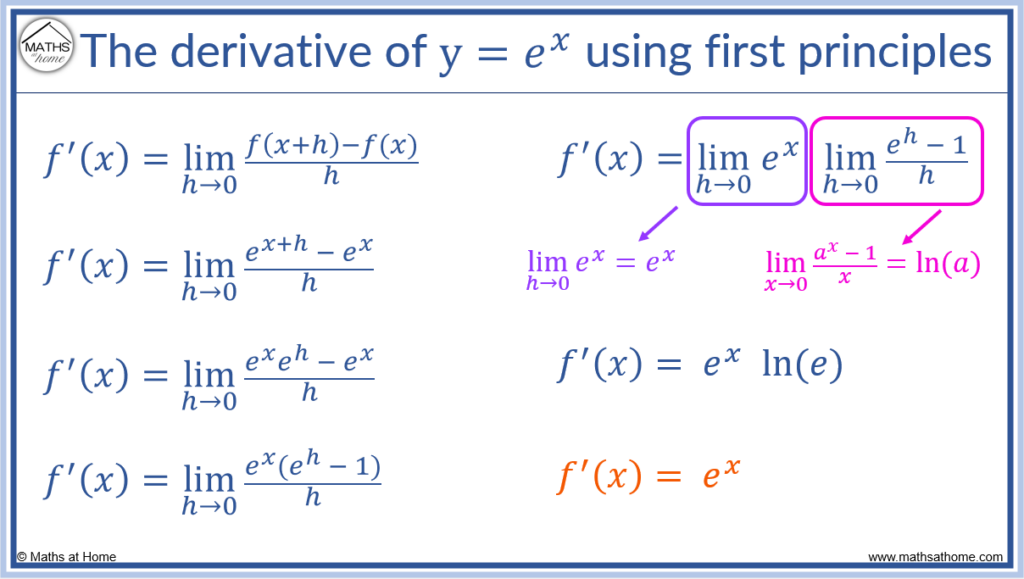
- If
, then
.
- The
term can be written as
.
- The first principles formula then becomes
.
- The
term can then be factored out to give us
.
- This limit can now be separated into two limits
.
because there are no h terms in
.
- Since
, we can see that ,
, which equals 1.
becomes
Proof of the Derivative of e𝑥 using Series
ex can be written as a power series as
Each term can be differentiated to give the term before it.
For example, 1 differentiates to 0, x differentiates to 1, x2/2 differentiates to x and so on.
Since there are an infinite number of terms in this power series, the series remains the same upon differentiating it.
differentiates to
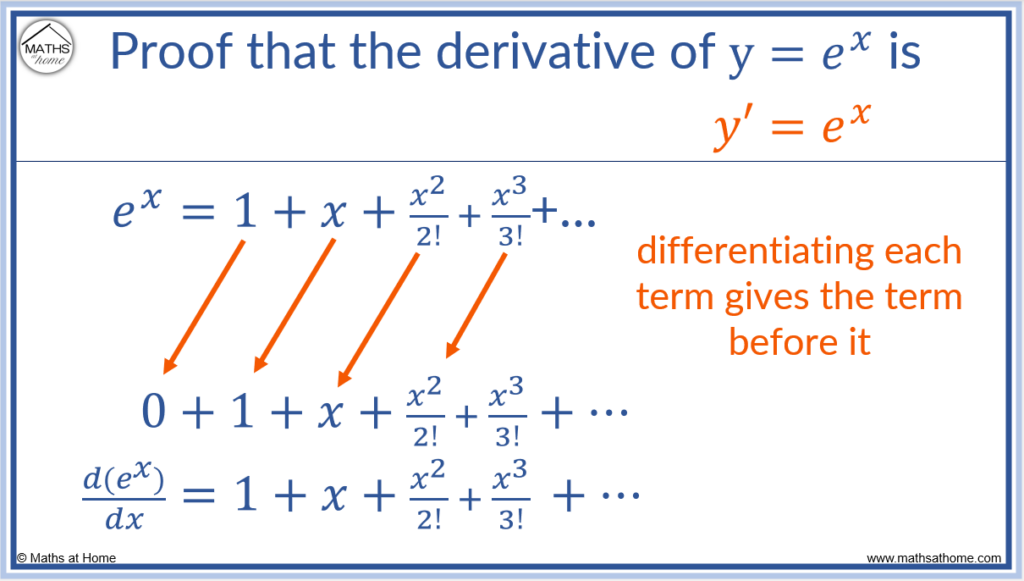
How to Differentiate f(𝑥) = a𝑥
The derivative of ax is ax ln(a). This rule is true for any value of a greater than 0. For example if y=2x, then dy/dx = 2x ln(2).

For example, if y = 5x, then dy/dx = 5x ln(5).

Proof of the Derivative of a𝑥
The derivative of y=ax can be proved by substituting a with eln(a).
y=ax becomes and the power of
can be brought down in front of the ln to make
.
We can differentiate this using our rule for differentiating exponentials: becomes
.
Here and so,
.
We obtain .
We can move the in front of the ln(a) back to the power of the ln(a). We obtain
.
Now and so
.

